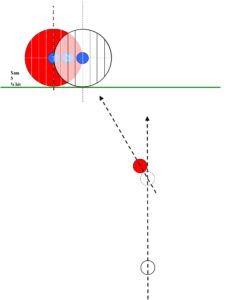Cuemechanics
How do you aim?
Some league players and students ask me this question: How do you aim? My responses might include:
- Are you asking me, personally, how I aim? Or do you mean ‘How SHOULD you aim’ ?
- A better question to ask is: How do YOU aim? I certainly can’t read your mind and even if I could, the human brain is capable of making so many computations so rapidly, that I doubt another person (trying to figure out what YOUR brain is doing) could consciously keep up with them all.
- If you can explain how YOU aim, so that someone else can understand, you probably have a good conscious grasp of what you’re doing. If you can’t explain what you do in a way to teach someone else, then maybe you don’t really know what you’re doing even if your aiming does usually work.
A master instructor asked students in one of our classes: “How many aiming systems do you think there are?” It’s a bit of a trick question, since the answer is thousands or maybe even millions. Not all published, of course. Perhaps millions is a bit optimistic, but we hope that millions of people play cue sports and therefore, since no one can download and analyze the brain activity of each of those people, it is safe to say that every one of them has something unique about the way they visualize and compute what they need to do to aim a shot.
There are many aiming systems for pocket billiards, to pocket balls directly or via a bank shot. Some pocket billiard magazine articles and instructional texts have claimed that the best players in the world use what is called Fractional Aiming. Most of what I’m presenting here would fall under the realm of fractional aiming, I think.
So I’ll attempt to explain to you what I do, when I’m aiming shots. Hopefully, if you’re a beginner who’s trying to figure out how to aim better, it may help you see some of the free aiming references that are always there on the table. You might even be an intermediate player or better, and maybe you still have some shots that always bug you. It could be that you don’t have an aiming system or method at all. Maybe you don’t have consistent, repeatable routines that you use before and during every shot – you’d be better off if you did.
IMPORTANT DISCLAIMERS:
- If you don’t have good mechanics and a consistent, repeatable stroke, no aiming system will work for you consistently. If the tip of your cue stick is moving up at the finish of your stroke, or down before the end of your stroke, side-to-side, or generally looks like it’s a car on a roller coaster during your stroke, start by tuning up your stroke first. You’ll be glad you did.
- Please don’t measure the diagrams presented here and message me telling me that this line is 2 pixels off center or that target spot is off by 3 degrees. I didn’t put this together using a CAD or ray-tracing software package (the fractional aiming diagrams at the end ARE very accurate but again, weren’t done with a CAD program). It’s meant to be a general guide on an aiming visualization method. If you don’t yet have a method, or if you need something for those shots that bug you, maybe this can help.
- None of this information takes friction-induced throw into account. However, the shots shown would work with a rolling cue ball and no side spin. Your experiences might vary, especially if the balls you use look like they’ve been rolling around in the street.
- If you gain anything by reading this and applying the concepts, great. It’s why I put the time and effort into it. At my risk, I might add, of making some of the people I play against EVEN better. I don’t mind constructive discussion of what I’m presenting but if you just don’t get it or you think it’s b.s., don’t waste our mutual time with insulting messages – it didn’t cost you anything.
So let’s start downloading information out of my brain. Hopefully we can make some sense of it.
We’ll start with an angle that I think everyone can visualize, with little disagreement on how to aim the shot: zero degrees (or 180, if you like), or a straight-in shot. This is the view you would have as you’re standing, preferably about a yard away from the table and with your head generally over the same line as the shot. There are actually two lines to see here: the line out of the pocket, through the object ball, and the line from the cue ball (the line of the shot) to where it contacts the object ball. In this case, the two lines are one, through the center of both cue and object balls.

Do we need a ghost ball visualization to help aim this shot? Not really, since it would completely cover the object ball, thus:

So what’s the best advice for aiming an absolutely straight shot? After stepping into your shooting position, and BEFORE you even start practice strokes, ask yourself this question: ‘Do I like my aim?’ Don’t bother starting practice strokes until the answer is ‘Yes’. Why confuse your brain by practice stroking along any line that isn’t THE line that (you think) makes the shot?
How do you know you’re lining up your cue on the center of both cue and object balls? Here is one aiming tool that never changes: the center of any ball on the table, from wherever you view it, is where it touches the bed of the table. Got that? It’s amazing how many people still find that tidbit of info enlightening. Yeah, I know its dark under that ball, the dark area is fairly wide and your eyesight might not be 20/20, BUT it may beat trying to imagine a center aiming point on a shiny sphere (for some people). If nothing else, it’s a good reference point to start with.

If the picture above looks a bit fuzzy, don’t worry: this is how things look without my glasses on 😉 So you see why it’s easier for me to judge center by looking at the bottom of the ball, instead of trying to focus on those fuzzy imaginary dots.
Reference points are always there for you. The center point on cue and object balls, as well as the right or left edge of both balls, are commonly used aiming and sighting tools for systems like fractional and Center-To-Edge (CTE) aiming. Just Google it… Thankfully, you don’t have to do any stick-pivoting, addition or subtraction to benefit from using the center or edges of any ball as aiming guides, unless YOU choose to, of course. If you really want to torture yourself, look up Jack Dunbar (last seen in Seattle, I think) and ask him to teach you the 37-or-so aiming systems he knows. He tried, on more than one occasion, to teach me all of them on a single league night, or at least that’s how it replays in my nightmares. All joking aside, I really like Jack. Honestly I do, Jack!
At any rate, next shot is NOT straight in, as you can see. We’re already standing on the line of the shot, using our cue as a guide. I didn’t have any helpers or hand models, so bear with the chalk bridge:
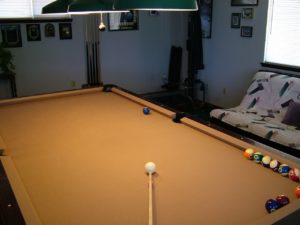
Now let’s look at the lines of the shot. First one coming out of the pocket, through the 2-ball:

If you’re good at imagining the line above, you can also imagine the contact point, where you want the cue ball to hit the 2-ball. See that little red dot below? Think you can maintain focus on exactly where you think that 2 millimeter contact point is? Good luck. I see lots of people who stand on the line of the object ball-to-pocket, burning that spot into their brain, I assume, then they go stand on the line of the shot and try to keep that contact point memorized. If they can do it, good for them. I know I can’t. However, if you can imagine where that spot is, by drawing a line out of the pocket and through the ball, you get a quick idea of how much of the object ball needs to be hit – a little, or a lot?

‘Ghost ball’ is an often-used concept for teaching aim and it is used here to help visualize the cue ball at contact with the object ball. I know my ghost ball isn’t very ghostly. Maybe I should get one of those clear Lucite cue balls. Actually, someone needs to make one with a glowing dot at its core. Anyway, ghost ball visualization helps with seeing the second line of the shot.

All these photos show the obvious problem with using 2-dimensional geometry to help explain aiming same-sized objects in 3 dimensions: when they are at different distances from your eyes, closer they appear larger and farther away they look smaller. Fortunately, most human brains do the complicated computations to help you cope with this. If yours doesn’t, maybe you should try knitting, instead of pool. (just kidding).
I don’t try to memorize or aim at the imaginary 2-ball contact point I gauged for myself. It’s just one gimmick I use to quickly judge how much of the object ball I need to hit. The real measure we’re after is how much overlap – cue ball to object ball – exists on the shot. Another way of expressing this is how full or thin is the hit? In the example below, the hit is almost 1/2 ball. That is, the left edge of the cue ball is almost lined up with the center of the 2-ball, or the point which divides the 2-ball in half. Who knows how your brain processes information? You may recognize the thickness or thin-ness of the hit required to pocket the ball as soon as you recognize the angle of the shot.

In Fractional Aiming, both balls might be divided into 8 (or more) equal parts, width-wise, and then you can map the angles that result from different amounts of overlap (ignoring things like the friction of badly worn or dirty balls and side spin on the cue ball). You may or may not become very good at visualizing equal 1/8 ball-width dividing marks across an object ball or cue ball. If you do, you will likely become very good at aiming shots. Even if you don’t, knowing about it will still help you gauge your thick or thin hits. Just knowing about the center, left and right edge of a ball, which you know how to find and which will never change, gives you 3 of the 9 one-eighth division points on a ball. Yes, I said 9. Draw a square and divide it into 8 equal parts, one side to the other. You will end up with 9 lines.
From there, it’s easy to get 2 more points: halfway between edge and center of a ball, on either side. Now you have 5 of nine points easily visualized. The remaining 4 points are just half-way between any consecutive two of the 5 points you’ve already easily identified (might help to refer to your square drawing again). At the end of this picture-laden manifesto, there are even MORE pictures, in the form of 2-dimensional diagrams, with shot angles and fractional aiming overlap accurately depicted. Enjoy.
So without a ghost ball, what does your sight picture look like? DO YOU LIKE YOUR AIM? Don’t start your practice strokes until you do.
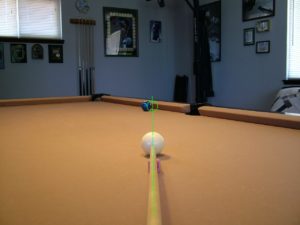
Now let’s look at a thinner hit. Not a wildly difficult shot, but many would groan at this leave:

I’ve already done the imagineering on this shot for you and I’m using the spot on the left side of the 3-ball to help gauge how thin the hit needs to be. Note that the line to the pocket is aimed at the end of the side cushion, NOT the center/back of the pocket.
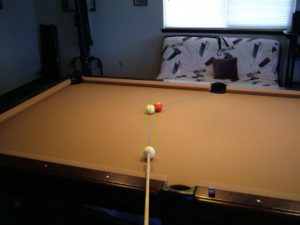
It’s not a 1/2-ball hit. Looks less than a 1/4-ball hit. It still looks like it’s just a bit fatter than an 1/8 ball hit. At this angle and this distance to the side pocket (these side pockets are generous), this shot, perfectly aimed, will go with 3/4 inch to spare on either side. Food for thought. A bar box is certainly a lot less forgiving on this shot.
Here is your sight picture. DO YOU LIKE THE AIM?

Next shot: 4-ball to the corner pocket. Standing on the line of the shot, aiming method begins. Note that if you never look at the shot from up here, how will you ever see the angle of the shot? You won’t see the angle by starting out in your eyes-down-the-rifle-barrel shooting position.

Add the ghost ball. The channel lines I’m showing are another imagination gimmick that some people use. Makes sense because your object ball is 2.25 inches wide and that’s a sizeable portion of the mouth of every pocket. Try picturing that channel for your object ball and see what you think. I also include some diagrammed examples of a ‘channel’ visualization after all the fractional aiming diagrams at the end of these photos.

You know, this looks like it’s shaping up as almost a 1/2-ball hit (again). You actually shoot many of the same angled shots several times in most of your games. They just look like different shots because the cue and object balls lay in different places on the table. Here’s a bit of a different take on the sight picture. With the outline of the object ball, you almost get that 2-dimensional overlap picture that tells you how thin or thick the hit is. You don’t really need to see the full outline of the object ball though, since you already know where its center is, and where the left edge of the cueball is – right?

Just a bit less than a 1/2-ball hit. Perfect aim on this shot still leaves 7/8 inch leeway on either side of the ball, at the corner pocket (my corners are 4 inches wide), so you’ve got a few degrees to play with. Pardon the lean of the table. The waves were high when these pictures were taken and the houseboat was really rocking.
Last shot we’ll look at is another thin cut, on the 8-ball. You need to play better position so you don’t leave yourself in these situations. Or beat your opponent already, before he can leave you like this.
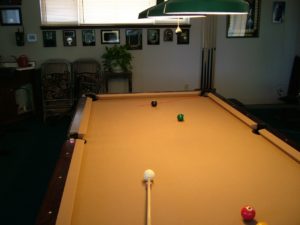
Get good at imagining that line out of the pocket and it almost immediately places your ghost ball or figures your fractional hit for you.

It’s definitely not a 1/2-ball hit. It’s even thinner than a 1/4-ball hit, but it looks slightly fatter than an 1/8-ball hit. Now don’t think you’re going to stand there debating the numbers on every shot for the rest of your life. Remember: your brain is like a super-computer when it comes to recognizing and calculating these types of visual inputs. Maybe not after several gin-and-tonics but… you know what I mean. You may start out slow if you’ve never looked at aiming this way before BUT with practice AND if you use a consistent routine of aiming every shot, it will become second nature before long.

What follows are diagrams I did for fractional aiming, based on the Masters Pool School (Dallas, TX) Stick Aiming Method instruction. Masters and Cue Tech Pool Schools have evolved. You can find
Randy Goettlicher at:
and Scott Lee at:
Note the blue dot(s) in every diagram which depict your cue tip. This is how you would aim on center-ball, no sidespin shots.
At the very end, there are a couple of examples of a channel visualization for shots.


